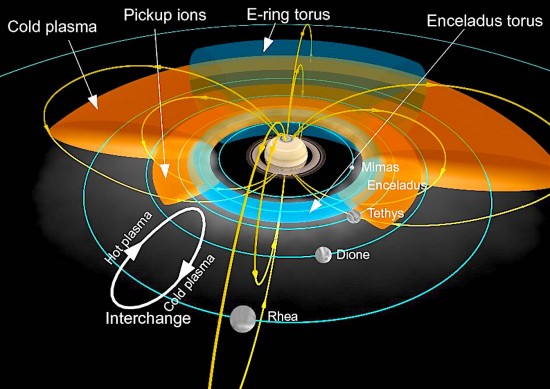Feb 22, 2016
Saturn exhibits a circuit between Enceladus and its electrical environment.
The Galileo space probe’s mission to Jupiter identified electrical activity between several moons and Jupiter’s vast magnetosphere. What were called “volcanic” plumes erupt from Io, injecting considerable volumes of ionized material into the gas giant’s plasma environment. In an Electric Universe, filamentation and the ionization mean that the plumes result from cathode arcs, electrically disintegrating the surface, while blasting sulfur dioxide “snow” 150 kilometers into space.
Io acts like a generator as it orbits within Jupiter’s plasmasphere. That orbital movement induces approximately 400,000 volts across the moon’s diameter at more than three million amperes. That 1.3 trillion watt electric flux flows into a plasma sheath (Jupiter’s magnetotail) where it circulates.
According to a recent press release, Saturn and its tiny moon, Enceladus share in the collection of ionized material in its own vast magnetosphere. Saturn’s magnetosphere extends beyond Titan’s orbit, approximately 1.2 million kilometers away, although it could be much larger. The Cassini spacecraft found, for the first time, that Saturn’s ionosphere was occasionally providing a similar quantity of plasma as does its moon.
Said Marianna Felici of the Mullard Space Science Laboratory at the University College, London:
“By measuring the flux of particles in the magnetotail and mapping them to the auroral outflow region, we calculated that the total amount of mass emitted per second may be as large as the rate at which mass is emitted from Enceladus. It is unknown how much of this mass stays in the magnetosphere and how much escapes down the magnetotail and joins with the solar wind.”
On Earth, streams of charged particles from the Sun are captured by the magnetosphere, and along with ions generated by Earth itself, collect in a plasma sheet within the magnetotail, where they are held together by Earth’s magnetic field. Similar processes were never witnessed at Saturn until Cassini’s observation. The particles in Saturn’s magnetotail were seen to change: ionized water ions disappeared while H+ ions took their place. The team reports that this is consistent with charge flow (ionized particles) from Saturn’s upper atmosphere.
Astronomers suggest that ionized vapor plumes from Enceladus are due to Saturn’s gravity “kneading” the moon as it orbits. The ionized particles then flow along Saturn’s electromagnetic connection with its moon. Since electricity does not flow in one direction the one-way connection cannot be correct, so how is the electricity moving between Enceladus and Saturn?
On August 11, 2008 Cassini’s plasma sensors found ion and electron beams propagating from Saturn’s northern hemisphere, creating an ultraviolet “footprint” in the auroral oval. A correspondence was found between time-variable emissions from the “vents” on Enceladus and the auroral footprint’s brightness variations.
Since Saturn is electrically connected with the Sun, an electrical interaction between Saturn and its moons means that they are charged bodies and are not neutral. Saturn exists in a dynamic electrical relationship with its orbiting family.
Stephen Smith
Hat tip to William Thompson













